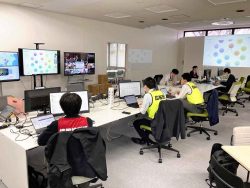- Yomiuri Editorial
- Next-generation fighters
Development must boost defense and improve Japan’s technology
12:30 JST, December 13, 2022
This is the first time for Japan to jointly develop defense equipment with countries other than its ally, the United States. The program by Japan, the United Kingdom and Italy must contribute to raising the level of Japan’s defense industry and strengthening its technological base.
The three countries have agreed to jointly develop their next generation of fighter aircraft. Design work is said to begin next fiscal year, with the aim of deployment around 2035.
In recent years, Japan and the United Kingdom have conducted a series of joint training exercises, including in the realm of cyber defense. An agreement to facilitate reciprocal visits between the Self-Defense Forces and the U.K. military is also being coordinated for conclusion in the near future.
The latest program, which includes G7 member Italy, must serve as an opportunity to further deepen security cooperation.
Japan and the United States have also considered joint development of next-generation fighter jets, but the United States has reportedly been reluctant to share confidential information such as software details. If the information cannot be shared, there is concern that Japan would not be able to upgrade the aircraft in the future, resulting in ballooning maintenance costs.
Japan, Italy and the United Kingdom already had similar timelines for the start of development and deployment of next-generation fighter jets. The agreement to share classified information was also a key factor to decide on the joint development.
In conjunction with the announcement by the three countries, the United States announced a policy of joint research with Japan on an unmanned aircraft that would complement the operation of the next-generation fighter aircraft.
If the equipment can be made interoperable, joint response capabilities will be improved. The government should deepen cooperation with the North Atlantic Treaty Organization, which includes the United States, to enhance deterrence effectiveness.
The Air Self-Defense Force currently operates a total of 300 fighter aircraft in three models. Of these, about 90 F-2 fighters, which are the only model not imported but jointly developed with the United States, are scheduled to be retired from service in the 2030s. The next-generation fighter to be developed by Japan, the United Kingdom and Italy will be the successor to the F-2 jets.
Mitsubishi Heavy Industries, Ltd., IHI Corp. and Mitsubishi Electric Corp. will participate in the program as the main contractors from Japan. More than 1,000 companies are reportedly expected to be involved in the manufacturing of the aircraft, including the procurement of parts for the fuselages and engines. It is important to nurture expert personnel and pass on the technology to future generations.
The development of fighter jets with advanced functions, such as stealth performance, often takes the form of a joint effort by countries because of the enormous cost involved.
The latest development program is expected to cost several trillion yen. Japan, the United Kingdom and Italy will try to reduce their own burdens by sharing the costs, but at the same time, they must also strive to reduce the overall costs in the first place.
The United Kingdom is considering exporting jets completed in the development project to third countries as part of its emphasis on cost-effectiveness. But Japan limits the use of exported defense equipment to such purposes as rescue and surveillance — a factor that has stalled transfers of defense equipment overseas. Expanding sales channels is an important issue.
(From The Yomiuri Shimbun, Dec. 13, 2022)
"Editorial & Columns" POPULAR ARTICLE
-

Violations of Subcontract Law: Major Automakers Must Eliminate Old Practices
-

Local Governments’ Tax Revenues: Devise Ways to Correct Imbalances in Tax Sources
-

5 Japanese Business Dinner Mistakes to Avoid — and What They Taught Me About Business in Japan
-

Heavy Rains in Asia: Support for Victims, Flood-Control Measures Urgently Needed
-

New Nuclear Threat: China Seeking to Follow U.S., Russia in Military Expansion
JN ACCESS RANKING
-

Keidanren Chairman Yoshinobu Tsutsui Visits Kashiwazaki-Kariwa Nuclear Power Plant; Inspects New Emergency Safety System
-

Imports of Rare Earths from China Facing Delays, May Be Caused by Deterioration of Japan-China Relations
-

University of Tokyo Professor Discusses Japanese Economic Security in Interview Ahead of Forum
-

Japan Pulls out of Vietnam Nuclear Project, Complicating Hanoi’s Power Plans
-

Govt Aims to Expand NISA Program Lineup, Abolish Age Restriction





















